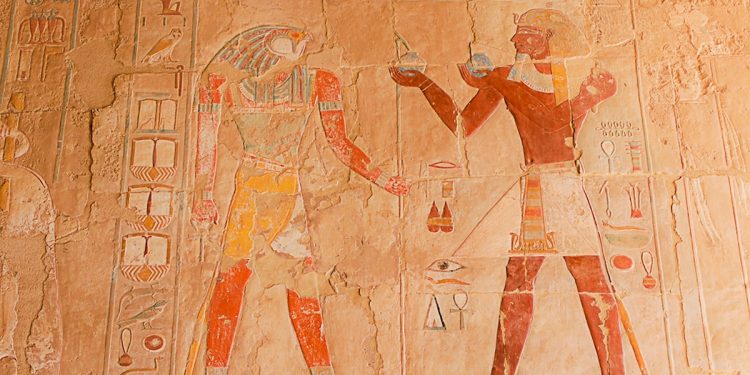Luxor is an hour’s flight up the Nile from Cairo. Luxor grew out of the ruins of Thebes the capital of Egypt from about 1500 to 1000 B.C. Now it is one of the Middle East’s major attractions.
Luxor has suffered badly in recent times because tourism almost collapsed, but now there are signs of a pick-up. Direct flights from many European cities ceased and the once-thriving river services to and from Aswan virtually stopped. Some of the 300 or so riverboats that took tourists in relative luxury along the Nile are back in business but most are still tied to the banks and many are rotting away.
This means it is a great time to visit. Hotels have cut prices, tour guides are readily available, crowds are nowhere to be seen and everyone is going out of their way to be friendly, helpful and courteous. Safety is on everyone’s minds and I must say my wife and I felt completely at ease everywhere we went.
The city has a nice riverside promenade, a flotilla of ferries crossing the river, huge hotels facing the Nile, and restaurants and markets competing for the relatively few tourists. The streets jingle with the sounds of bells on horse carriages, which we initially took to be for tourists, but actually they are part of the local transport scene.
The Temple of Amun (Karnak Temple)
This complex of three temples built over a 2000-year period is probably the biggest temple on earth. Our expectations were high and as we wandered the site we became more and more impressed. The stillness of the whole place with its stone columns soaring against the brilliant blue sky was breathtaking.

The surfaces of the grand courtyards are all covered by fine carvings. The scale and detail is staggering. I thought of the vision, the work and the investment that went into this huge structure and then was told that all this could not even be seen at the time by the public. It was only for priests, royals, and the gods.
A millennium later the public entered. We saw marks on the columns where Roman soldiers sharpened their swords, and early Christian images of Mary and Jesus are carved on the ancient pillars like graffiti. Many of the statues have had their noses cut off by the Romans to destroy the Pharaohs rebirth system, because Egyptians then believed that the soul needed to re-enter the body via the nose.
The Luxor Temple
The Luxor Temple is all about the great warrior pharaoh, Ramses II even though it was started 100 years or more (around 1380BC) before his reign. Two 25m pink granite obelisk built by Ramses once stood before the entrance gateway but today only one remains; the other stands in the Place De La Concorde in Paris.

The temple has been in almost continuous use as a place of worship. During the Christian era, the temple’s hypostyle hall was used as a Christian church. Then for many centuries the temple was buried and a mosque was eventually built over it. This mosque was carefully preserved when the temple was uncovered and forms an integral part of the site today.
Originally an avenue lined with sphinxes ran the entire 3 kilometres between the Luxor and Karnak Temples. This avenue is currently under excavation and reconstruction and you see a short completed section near Luxor Temple.
The Valley of the Kings
In about 1600 B.C. there was a big change in the style of royal tombs. Until then, kings were buried in pyramids, but these were consistently being robbed, which meant kings were waking up in the afterlife without their precious earthly possessions. So, rather than mark their tombs with big pyramids, the kings started hiding their tombs underground in the valleys on the west side of the Nile.
Each buried king was provided with all the necessary things that would provide a comfortable existence in the afterlife, however, most of this has been looted over the centuries so most tombs were empty when they were rediscovered in modern times. The condition of the 63 tombs that have been discovered and the details on their walls, however, is incredible after all these centuries. Most are decorated with scenes from Egyptian mythology.
Most of the tombs are not open to the public. The entry ticket to the valley allows you to visit three tombs out of several that are open but some require additional payment. The cost is reasonable and the visitor arrangements are good, however, be aware that in summer the temperature can be stifling. Photography is not allowed in the tombs.
The Hatshepsut Temple
This is perhaps the most spectacular structure on the west bank. The mortuary temple was only discovered about 150 years ago and there is still some on-going restoration work underway. The temple rises out of the desert in a series of terraces that from a distance merge with the sheer limestone cliffs behind.

This temple was built by Queen Hatshepsut, the first known female monarch, who ruled for about two decades. Her reign was one of the most prosperous and peaceful in Egypt’s history. When Thutmose III followed her as pharaoh, he had all evidence of her reign destroyed by erasing her name and having her image cut from all public monuments, even within this temple.
Although unknown for most of history, in the past 100 years her accomplishments have achieved global recognition and her stunning mortuary temple has become one of the most visited structures on the West Bank.
Need to Know
There are few facilities for visitors on the West Bank. Most stay in Luxor and travel to the West Bank by bus or on a tour. Hotels and restaurants in Luxor are good and prices are very reasonable at present. You need a minimum of two days to see the major attractions.
Air access from the United Kingdom is via Cairo.












